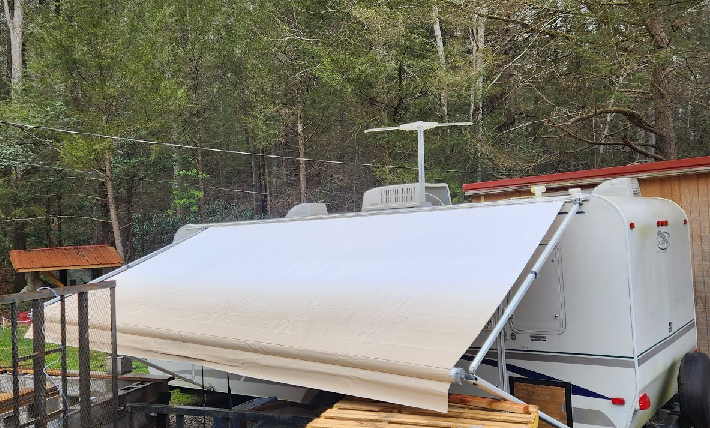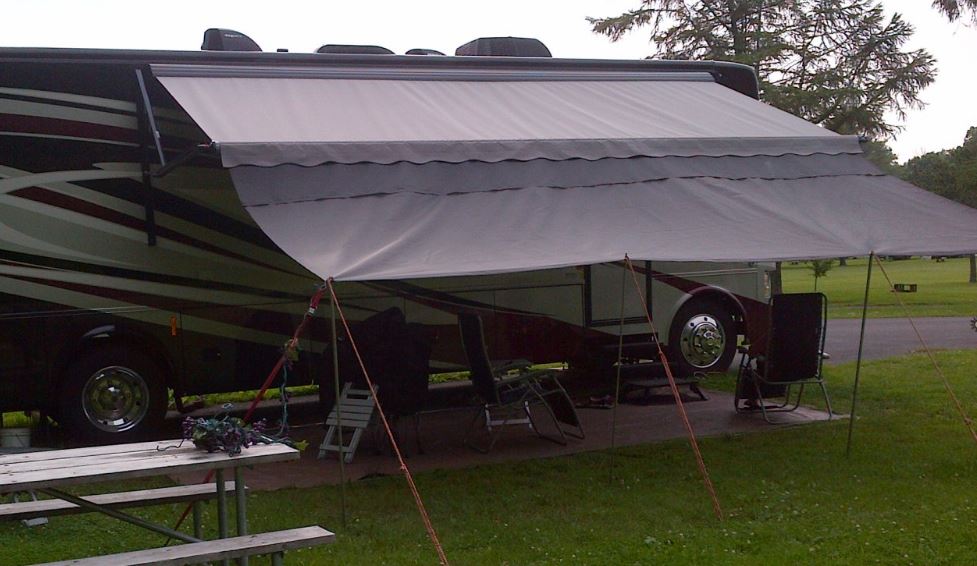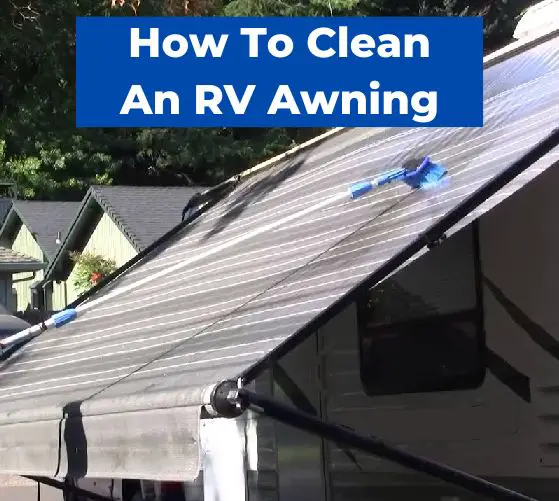RVing is a fun and exciting way to experience the great outdoors, and RVs provide a comfortable and convenient way to do it. After a while your RV awnings can become dirty, moldy, and stained, detracting from the overall experience. Knowing how to clean an RV awning is a necessary RV maintenance task that can be done quickly and easily with the right tools and techniques.
There are several methods for cleaning an RV awning, but the most effective method depends on the type of awning material. For example, vinyl awnings are easier to clean than fabric awnings, but they still require proper care to maintain their appearance and functionality.
The key to cleaning an RV awning is to use the right cleaning solution and tools, avoid using harsh chemicals that can damage the material, and following a specific process that will make your RV awning look brand new.
We’ll go over everything you need to know about RV awning cleaning from supplies to technique in this guide.
How Often Should I Clean My RV Awning?
Cleaning your RV awning is an important part of maintaining your RV. But how often should you clean it?
According to most RV experts, you should plan on cleaning your RV awning at least once a year. This is typically done when you winterize or dewinterize your RV and put it into storage.
It’s important to note that if you notice any mold or mildew on your awning, you should clean it right away. This is because mold and mildew can spread quickly and cause damage to your awning.
Additionally, if you’ve camped under trees that have dropped a lot of pollen, sap, or debris, you should clean your awning as soon as possible. This will help prevent any stains or long-term damage to your awning.
Overall, it’s important to clean your RV awning regularly to keep it in good condition and extend its lifespan.
Gathering RV Awning Cleaning Materials
Before beginning the process of cleaning an RV awning, it is important to gather all the necessary materials. This will ensure that the cleaning process goes smoothly and efficiently. The following materials are required:
- A ladder: A ladder is necessary to reach the top of the RV and the awning. It is important to make sure that the ladder is stable and secure before climbing it.
- A bucket: A bucket is needed to hold the cleaning solution and water. It is important to use a bucket that is large enough to hold the necessary amount of water and cleaning solution.
- A hose: A hose is needed to rinse the awning before and after cleaning. It is important to use a hose with a spray nozzle to control the water pressure.
- A soft bristled brush: A bristle brush is necessary to scrub the awning and remove any dirt or stains. It is important to use a brush with soft bristles to avoid damaging the awning.
- Dish soap: Dish soap is needed to create the cleaning solution. It is important to use dish soap that is gentle and does not contain any harsh chemicals. There are some special RV awning cleaning solutions out there that also work great, but you don’t need to spend extra money on them if you don’t want to.
- A pressure washer (optional): A pressure washer can be used to clean the awning more efficiently. However, it is important to use a pressure washer with a low pressure setting to avoid damaging the awning.
Once all the necessary materials are gathered, it is important to set them up in a convenient location. This will make the cleaning process easier and faster.
It is also important to wear appropriate clothing and protective gear such as gloves and safety glasses to avoid any injuries.
Natural, Acrylic, Or Canvas Awnings
Most fabric, canvas, or acrylic awnings are manufactured by Sunbrella. Their awnings are UV resistant, dry quickly, and are very breathable.
Canvas awnings have a repellent finish that blocks out water stains and oil stains, but the finish can fade over time.
Vinyl Awnings
Vinyl awnings are good at resisting mildew, but are not mildew proof.
Cleaning the RV Awning

Keeping the RV awning clean is essential to ensure it lasts for years to come. Here are six simple steps to clean your RV awning:
- Mix Soap and Water: Mix a solution of RV awning cleaner by mixing cleaner and water at a 20% and 80% ratio. You can use any cleaner, but most people prefer using dish soap because it is soft and does not harm the RV paints. Hydrogen peroxide, car soap, green soap, or bleach can also work as a cleaning agent in the RV awning cleaning solution. Warm water will also boost your cleaning power.
- Fully Extend The RV Awning: To start cleaning the RV awning, extend it fully to expose the entire surface area.
- Brush On The Soapy Water: Cover your RV awning with your cleaning solution. You can use a spray bottle, a brush, or a pressure washer (just be sure not to tear the fabric!). Make sure to cover the top and bottom of the awning.
- Retract The Awning And Wait A Few Minutes: After you’ve brushed on the soapy solution set, roll up the awning and let it sit for anywhere from 15 to 30 minutes to allow the cleaning solution to penetrate the fabric and loosen any dirt or grime for a deep clean.
- Extend The Awning And Rinse: Extend the awning again and rinse it thoroughly with a hose. Make sure to rinse both sides of the awning to remove all traces of the cleaning solution.
- Dry And Repeat If Necessary: After rinsing, let the awning dry completely before retracting it. If you notice any remaining dirt or stains, repeat the cleaning process until the awning is completely clean.
By following these simple steps, you can keep your RV awning clean and in good condition for years to come.
Here’s a video of this process for you to see in action:
Maintenance Tips
Proper maintenance of an RV awning can extend its lifespan and keep it looking clean and new. Here are a few tips to keep in mind:
- Regularly clean the awning with a soft brush and mild soap to prevent dirt and debris buildup.
- Inspect the awning for any signs of wear and tear, such as holes or tears, and repair them promptly to prevent further damage.
- When retracting the awning, make sure it is completely dry to prevent mold and mildew growth.
- Use caution when using harsh chemicals or pressure washers on the awning, as they can damage the fabric and finish.
- When storing the awning for an extended period of time, make sure it is completely dry and free of any debris to prevent damage and odors.
By following these simple maintenance tips, RV owners can keep their awnings in top condition and prevent costly repairs or replacements.
How Often Should I Clean My RV Awning?

Keeping your RV awning clean is essential for its longevity and appearance. But how often should you clean it?
According to most RV experts, you should plan on cleaning your RV awning at least once a year. This is especially important if you are planning to store your RV during the winter months. Cleaning your awning before storing it away can help prevent mold and mildew growth, which can damage the fabric over time.
If you use your RV frequently, you may need to clean your awning more often. For example, if you camp under trees that drop a lot of pollen or sap, you may need to clean your awning after every trip. Similarly, if you live in an area with high humidity or rainfall, you may need to clean your awning more often to prevent mold and mildew growth.
It’s also important to note that regular cleaning can help extend the life of your RV awning. Over time, dirt and debris can build up on the fabric, which can cause it to deteriorate more quickly. By cleaning your awning regularly, you can help prevent this from happening and ensure that it lasts for many years to come.
Frequently Asked Questions
To remove tree sap from your RV awning, you’ll want to use a mixture of liquid dish soap and turpentine for acrylic, canvas, or natural materials, or use rubbing alcohol or a grease remover on vinyl.
Slowly work it into the tree sap to soften it, but not spread the sap around. Finish by washing with water and mild soap.
You may need to repeat a few times to get the sap completely off of your RV awning.
Bird droppings are unsightly and a pain to clean, plus they usually have juices or pigments from berries mixed in, contributing to a bigger stain.
Start cleaning off bird poop from your RV’s awning by scraping as much of the spot off as you can with something soft, like a soft-bristled brush or plastic spoon.
Next, mix water and dish soap in a bowl, and dab the area with a soft cloth, follow that up by blotting the spot with a dry cloth.
Repeat this process until the spot has vanished, and if you have a very stubborn spot you can treat it sparingly with a mixture of equal parts hydrogen peroxide and ammonia.
You can use a mixture of citric acid and water or oxalic acid and water to get rust and rust stains off your RV awning. Work the solution into the stain or spot, then rinse off.
Check out our other guides on how to make your RV look great while you’re here:
RV Skylight Replacement Process
Removing RV Oxidation From Fiberglass
20 Great Ideas For Decorating an RV

